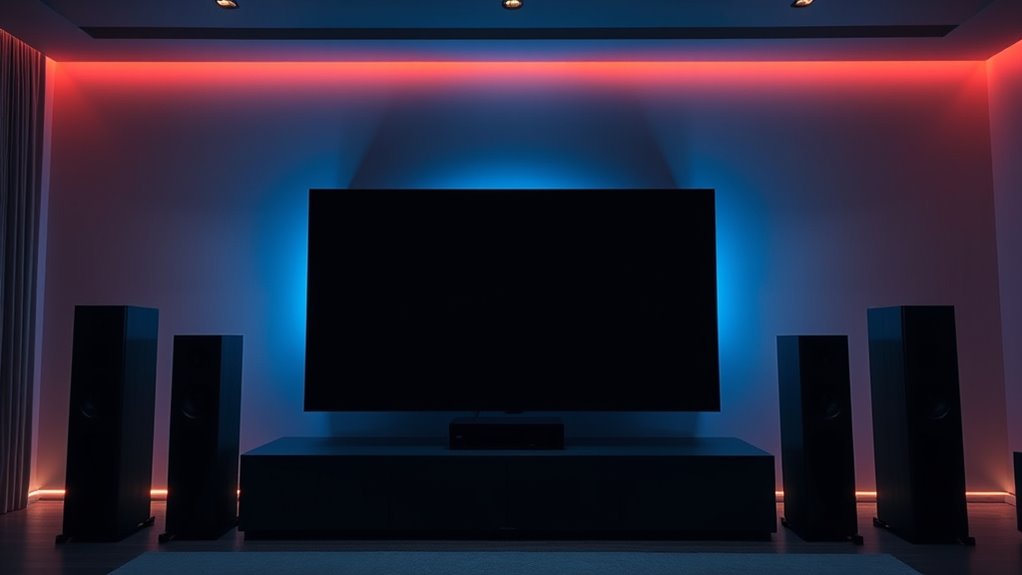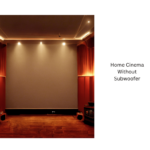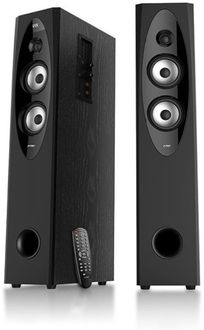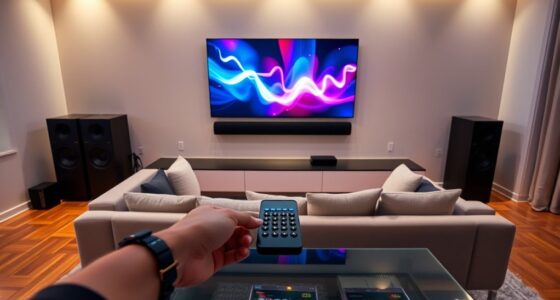Surround sound works by using multiple audio channels, each assigned to specific speakers placed around you, creating a 3D audio environment. In a basic setup, you’ll have stereo with two channels, but more advanced systems like 5.1 or 7.1 add extra speakers to give you richer, more precise sound tailored to the scene. Understanding how these channels are arranged and used will deepen your appreciation for immersive audio—keep exploring to discover more about this exciting technology.
Key Takeaways
- Surround sound uses multiple audio channels to create a 3D audio environment around the listener.
- Basic systems like 5.1 have five main speakers plus a subwoofer for depth and clarity.
- Additional channels, such as in 7.1 or Dolby Atmos, add rear and overhead speakers for enhanced immersion.
- Proper speaker placement and calibration are essential to achieve accurate directional sound.
- Understanding the roles of each channel enhances your ability to set up and enjoy surround sound systems.
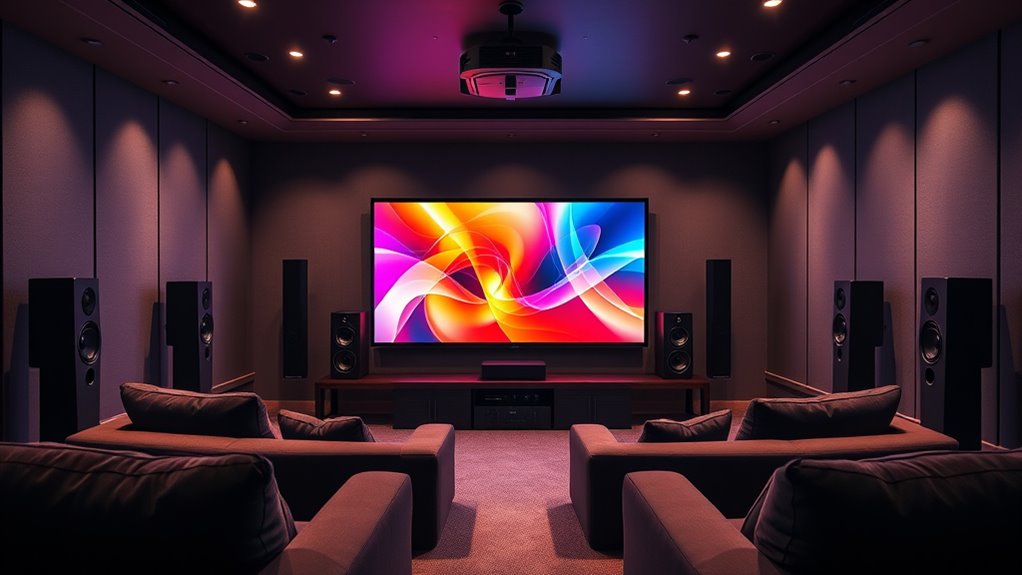
Have you ever wondered how movies and music seem to come alive with immersive sound? It’s all thanks to surround sound technology, which creates a three-dimensional audio experience that pulls you into the action or music. This setup makes you feel like you’re right there in the scene or concert, hearing every whisper, explosion, or note from the correct direction. Understanding the basics starts with the concept of audio channels. Think of each channel as a separate stream of sound that’s sent to a specific speaker. In a simple stereo system, you have two channels—left and right—that give you a sense of direction for music or dialogue. But surround sound takes this further by adding multiple channels, such as front, rear, and sometimes even overhead, to create a more detailed soundscape. This multi-channel setup helps differentiate sounds coming from different directions, making the experience more immersive. Most commonly, you’ll encounter 5.1 surround sound systems. The “5” refers to five main speakers: front left, front right, center, rear left, and rear right. The “.1” indicates a dedicated subwoofer, which handles low-frequency sounds like bass and explosions, adding depth to your audio. Together, these channels work harmoniously to deliver a balanced and dynamic sound environment. For example, during a movie chase scene, you might hear the screeching tires from the front, the distant sirens from behind, and the bass rumble from the subwoofer, making everything feel more real. There are also more advanced setups, like 7.1 surround sound, which adds two additional rear speakers, enhancing the spatial accuracy. Overhead or height speakers, used in Dolby Atmos systems, introduce a new dimension by placing sounds above you, such as a helicopter flying overhead or rain falling from the sky. These enhancements make the experience even more engaging, especially when you’re watching action movies or playing video games. Getting started with surround sound isn’t complicated, but understanding how each channel contributes helps you appreciate the technology. Whether you’re upgrading your home theater or just exploring audio, knowing that multiple channels and speakers work together to create a lifelike soundscape can transform your entertainment experience. Understanding audio channels and the importance of proper speaker placement are key concepts to creating an immersive environment. Proper calibration can also help prevent audio distortion, ensuring the clarity of every sound. Additionally, understanding how audio channels are assigned and balanced can significantly improve the overall sound quality of your system. Recognizing the impact of contrast ratio on picture quality can help you select a projector that delivers both stunning visuals and immersive sound, making your home entertainment setup more complete. For those interested in the technical aspects, exploring how audio system configuration influences sound accuracy can deepen your appreciation for surround sound technology. Once you grasp these basics, you’ll better understand how surround sound elevates your movies, music, and games, making every moment more vivid and enthralling.
Frequently Asked Questions
How Does Surround Sound Improve Gaming Experiences?
Surround sound greatly enhances your gaming experience by immersing you in the game world. It creates a realistic audio environment, allowing you to pinpoint sounds like footsteps or gunfire from different directions. This spatial awareness gives you a competitive edge and makes gameplay more engaging. With surround sound, you feel like you’re right there in the action, making every moment more intense and enjoyable.
Can I Upgrade My Current Stereo Setup to Surround Sound Easily?
Ever wondered if upgrading your stereo to surround sound is simple? You can definitely do it, but it depends on your current setup. Typically, you’ll need a surround sound receiver and some additional speakers. Do you have space for extra speakers? If yes, connecting them is straightforward, and you’ll notice a huge difference in audio immersion. Just make sure your source devices support surround sound, and you’re good to go!
What Are the Differences Between Dolby Atmos and DTS:X?
Dolby Atmos and DTS:X are both advanced surround sound formats, but they differ in how they deliver audio. Atmos adds height channels for a more immersive experience, making sounds come from above you. DTS:X is more flexible, adapting to your speaker setup and placing sounds precisely in 3D space. You’ll notice Atmos feels more cinematic with vertical sound, while DTS:X offers tailored, customizable audio positioning.
Is Surround Sound Necessary for Casual TV Watching?
Many believe surround sound isn’t essential for casual TV watching, but it can enhance your experience. While you might get by with just stereo speakers, surround sound immerses you in the action, making shows more engaging. If you enjoy clarity and a richer atmosphere, investing in surround sound might be worth it. Otherwise, you can still enjoy your favorite content comfortably without it, especially if you prefer simplicity.
How Do Room Acoustics Affect Surround Sound Quality?
Room acoustics play a big role in your surround sound experience. If your room has hard surfaces like hardwood or tile, sound waves bounce around, causing echoes and reducing clarity. Soft furnishings like curtains, carpets, and furniture absorb sound, making audio clearer and more balanced. Proper speaker placement and acoustic treatments help optimize sound quality, ensuring you enjoy immersive audio with rich, accurate surround effects.
Conclusion
Now that you’ve uncovered the secrets of surround sound, you’re ready to transform your listening experience into something truly epic. With the right setup, you’ll feel like you’re at the center of the action—every whisper, explosion, and note immerses you completely. Remember, understanding audio channels isn’t just a skill; it’s your gateway to experiencing sound at a level so profound, it’s almost like hearing music for the first time all over again.
Hello, I’m Art, and I’m excited to be a part of the 1Home Theatre Projector team. As a writer, I’m here to contribute my knowledge and insights to help you achieve the ultimate home cinema experience. I understand that making decisions in the world of home entertainment can be complex, and I’m here to simplify the process for you.
